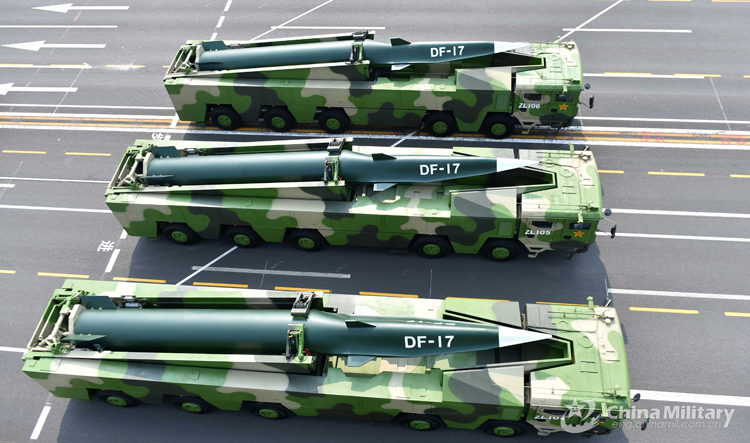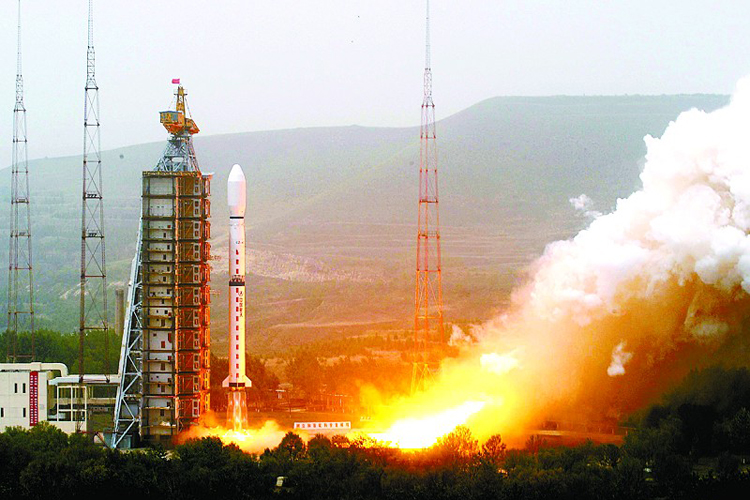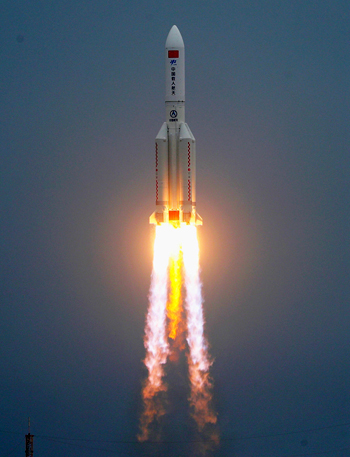China has made significant progress in developing anti-ballistic missiles (ABM) which like ASATs can also be used to target other nation’s intelligence, surveillance, reconnaissance and military satellites.
 |
The Author is Former Director General of Information Systems and A Special Forces Veteran, Indian Army |
(File Photo) Long March 5B
In its desire to dominate the world, China is weaponising space at a furious pace. Not only are militarisation and weaponisation of space fundamentally at odds with constructive commercial and scientific projects but China is focused on deploying weapons in space in order to dominate space giving it supremacy in the conduct of war over land, sea and air. Despite growing concerns over weaponsation of space, China brushes all observations aside saying its space programme is for defensive purposes only.
This is not surprising with Chinese President Xi Jinping, during his address to the last summit of the UN General Assembly (UNGA) saying China has never attacked any country (sic). With Xi set to get a third term in office and ambitions of lifetime presidency, the rouge character of China is likely to spring many surprises in coming years.
It was reported in these columns earlier that China tested its nuclear fractional orbital bombardment system (FOBS) in August this year. China launched a Long March rocket carrying a hypersonic glide vehicle into low orbit which circled the globe before descending to earth missing its target by over 38 km. The hypersonic missiles can reach speeds of up to 33,600 km/h and can strike anywhere from space within minutes. China had showcased advanced weaponry including its hypersonic missile ‘DF-17’ at its annual parade in 2019.
China was involved in the high-profile testing of its anti-satellite (ASAT) weapon and successfully destroyed a defunct Chinese weather satellite ‘FY-1C’ in low earth orbit (LEO)
On January 11, 2007, China was involved in the high-profile testing of its anti-satellite (ASAT) weapon. China successfully destroyed a defunct Chinese weather satellite ‘FY-1C’ in low earth orbit (LEO). The destruction was reportedly carried out by an SC-19 ASAT missile with a kinetic kill warhead. The cloud space debris created by China’s ASAT test drew international criticism but China simply ignored the issue. The US and the Soviet Union too had conducted ASAT tests during the Cold War, but these tests stopped after the 1980s because the debris puts valuable space assets and astronauts at risk.

China's hypersonic missile ‘DF-17’
China has also made significant progress in developing anti-ballistic missiles (ABM) which like ASATs can also be used to target other nation’s intelligence, surveillance, reconnaissance and military satellites. In addition, the Chinese military has also developed various types of ground-based weapons that could blind or damage a passing satellite with a laser beam.
China’s experimental ASAT probe ‘Shijian-17’ since its launch in 2016 was observed undertaking unusual maneuvers with its robotic arm by the US military. General James Dickinson, Commander of US Space Command, had told the US Congress that the technology adopted by the Shijian-17 could be used in a future system for grappling other satellites, and that Beijing is actively seeking space superiority through space and space attack systems. China’s anti-satellite programme in recent years has focused on technology that would produce little or no debris, like capturing a satellite by using a net or with robotic arms.
Now a team of Chinese military researchers from the Hunan Defence Industry Polytechnic in Xiangtan, working on a government funded project to develop a new type of warhead for rocket missiles, say they have “built and tested” an anti-satellite robotic device that can place a small pack of explosives into a probe’s exhaust nozzle. To avoid the problem of space debris caused by an ASAT blowing the satellite into pieces, the newly researched and developed “melt-cast explosive” can produce a time-controlled, steady explosion. The research paper was published in the domestic journal ‘Electronic Technology & Software Engineering’ in the October 2021 edition.
China’s anti-satellite programme in recent years has focused on technology that would produce little or no debris, like capturing a satellite by using a net or with robotic arms
The explosives are packed into a bullet shaped device that weights only 3.5 kg and mirrors the shape of the de Laval nozzles that powers most satellites. These are pipes with a narrow throat in the middle that converts gas into kinetic energy and, although they are based on a 19th century design by the Swedish engineer Gustaf de Laval, are still used on the most advanced satellites. The device works by pushing a rod through this narrow point, which then opens up to anchor itself into place by locking the device against the inner wall of the nozzle. When the device is detonated, the explosion will be partially contained inside the nozzle and could reportedly be mistaken for an engine mishap.
The device could stay inside the satellite for an extended period by using a locking mechanism driven by an electric motor. If needed, the process can be reversed to separate it from the target. The heat of the explosion, if precisely calculated, can be partly converted into kinetic energy and damage the satellite’s insides while leaving the overall structure intact. The melt-cast explosive chosen is already being used in China’s space programme for separating rocket stages and other purposes. China has also developed the technology to capture satellites, which cannot be objected to internationally because it also has the dual use for peaceful purposes like repairing or refueling satellites and removing space debris.

FY-1C launch
Now ‘stealth’ satellites are on the anvil including through coating a satellite in composite materials to absorb radar waves. With this development, a researcher from China’s Changchun Institute of Optics, Fine Mechanics and Physics says the use of stealth technology in space requires new laws and regulation. A research team in Nanjing, Jiangsu Province has developed stealth technology for use by small satellites to blind radar detection. The new stealth technology could reduce the strength of radar signals by more than 80 per cent, making the small satellite virtually invisible on a radar screen.
The Nanjing team said they could coat a satellite with layers of composite materials with a honeycomb structure that would absorb radar waves at all known operating bandwidths. Stealth satellites would counter enemy detection and surveillance.
The Nanjing team said they could coat a satellite with layers of composite materials with a honeycomb structure that would absorb radar waves at all known operating bandwidths. A transparent layer of signal absorption material made with rare earth elements was also added to the satellite’s solar panels, further reducing the chance of being tracked. Stealth satellites would counter enemy detection and surveillance. Needless to mention that stealth technology would start a new space race.
According to the US space agency NASA, the US Department of Defence global Space Surveillance Network (SSN) sensors are tracking over 27,000 pieces of space junk or orbital debris. Recently a defunct Chinese satellite nearly collided with the International Space Station (ISS), which was averted when the ISS maneuvered out of the way. Also a new study has found that very soon Earth could also have Saturn-like rings around it albeit of space junk.
In 2008, Russia and China had proposed a ‘Treaty on the Prevention of the Placement of Weapons in Outer Space and the Threat or Use of Force against Outer Space Objects’. This required signatories to promise not to place weapons or threaten or use force in outer space, avoiding any activities that are inconsistent with the purpose of the treaty. But the US and its allies have rejected the proposal, citing a number of concerns, including the lack of restrictions on the development of ground-based weapons that could be used in space and failure to include verification mechanisms.
So the space race will continue. Treaties anyway are just a piece of paper to a country like China who never means what it says and treats agreements and treaties like toilet paper.












